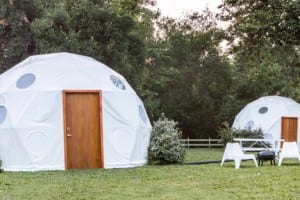Following the change of idea, I have recently spent time thinking about how I will now present my work. Now that I will only be using one screen, it has made it much easier to plan the exhibition. It was suggested that I consider a tent, or booth, so I can design the surroundings of the screen/s and further influence how the audience feels during the piece.
I began looking into pods, sheds, tents and domes. The two pictures below are from Shelter Solutions and Pacific Domes respectively. The first has an art installation inside it, and the second is an art studio.
These are the kind of structures I was researching to begin with, but I soon realised they were not what I was after. Both are probably the smallest size you can get, and I would like something a lot smaller, preferably only fitting one person at a time. This led me to start researching smaller pods and sheds (mainly sheds, Googling variations of ‘pods’ wasn’t that helpful), and I came across small outdoor storage boxes for garden equipment.
I’m not sure I would submit the viewer to crawling into a tiny box and not having a proper seat to sit on, but I would like a similar experience. However, they were just what I was after: isolating, cramped, dark and uncomfortable. Additionally, it would have the extra feeling of being isolated whilst surrounded by people, a very common feeling for those with mental health problems. If no one understands what you’re going through or how you feel, it can feel very lonely despite having a lot of friends around you, even if they’re offering help.
If I could find a slightly bigger space, I could line it inside, make sure as little light as possible was coming in and have a TV, iMac or screen of some sort in there.
These are some of the other options I found, which are a bit more like what I’m after, but they still might not be tall enough.
This one above is a lot taller, but not as wide. Having a taller space would allow people to walk into it normally, and would have plenty of headroom for taller folks sitting down. I could also hang some kind of drape from the ceiling to surround the viewer, which would cut out any light coming through the wood. This would have to be attached to the wall in several places so it didn’t pull the screen off it’s surface, but I can’t see that being a problem.





